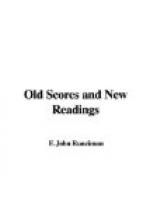to social pressure, marry Amneris, and throw over
Aida, or yield to passion, fly with Aida, and throw
over his country. All this shows the bad influence
of Scribe, who usually spent half his books in explaining
matters as simple and obvious as the reason for eating
one’s breakfast. Verdi knew this as well
as anyone, and used the two first acts as opportunities
for stage display. For “Aida” was
written to please the Khedive of Egypt; and Verdi,
always keenly commercial, probably knew his man.
Now, when the masters of opera—Handel,
Gluck, Mozart, Weber—got hold of a bad book,
they nearly invariably “faked” it by getting
swiftly over the weak points and dwelling on the strong;
and, above all, they flooded the whole thing with
a stream of delicious melody that hypnotises one, and
for the time puts fault-finding out of the question.
Not so Verdi. He wrote to please his audience,
and he knew that what one can only call dark-skinned
local colour was still fresh in spite of “L’Africaine,”
and that the vulgar would find delight in a blaze of
glaring banners and showy spectacle. So he set
the two first acts as they stood, trusting to local
colour and spectacle to make them popular; and, as
we know, at the time they were popular, and the populace
exalted Verdi far above such second-rate fellows as
Mozart and Beethoven. But now, when local colour
has been done to death, and when it has had a quarter
of a century to bleach out of Verdi’s canvases,
what remains to interest, I do not say to touch, one?
Certainly not the expression of Radames’ or
Aida’s love, for here as everywhere Verdi fails
to communicate any new phase of emotion, but (precisely
as he did in “Falstaff” and “Otello”)
has written music which indicates that he had some
inkling of the emotion of the scene, and could write
strains calculated not to prevent the scene making
its effect. That Verdi has no well-spring of
original feeling, perhaps explains why he is so poor
in the scenes with Radames, Amneris, and Aida. (Also,
perhaps, it explains why he has fallen back in his
best period upon masterpieces of dramatic art for
his librettos. It is almost outside human possibility
to add anything to “Falstaff” or “Otello”;
and such success as Verdi has made with them is the
result of writing what is, after all, only glorified
incidental music—music which accompanies
the play. To class these accompaniments with the
masterpieces of original opera is surely the most
startling feat of modern musical criticism.) Moreover,
the plan of writing each scene in a series of detached
numbers—for, even where song might flow
naturally into song, the two are quite detached—breaks
up the interest as effectually as it does in “Traviata”;
and the songs do not themselves interest. Verdi’s
music is not based, like the masters’, upon the
inflexions of the human voice under stress of sincere
feeling, but upon figures and passages easily executed
upon certain instruments. The great composers
strove to make instruments speak in the accent of the




